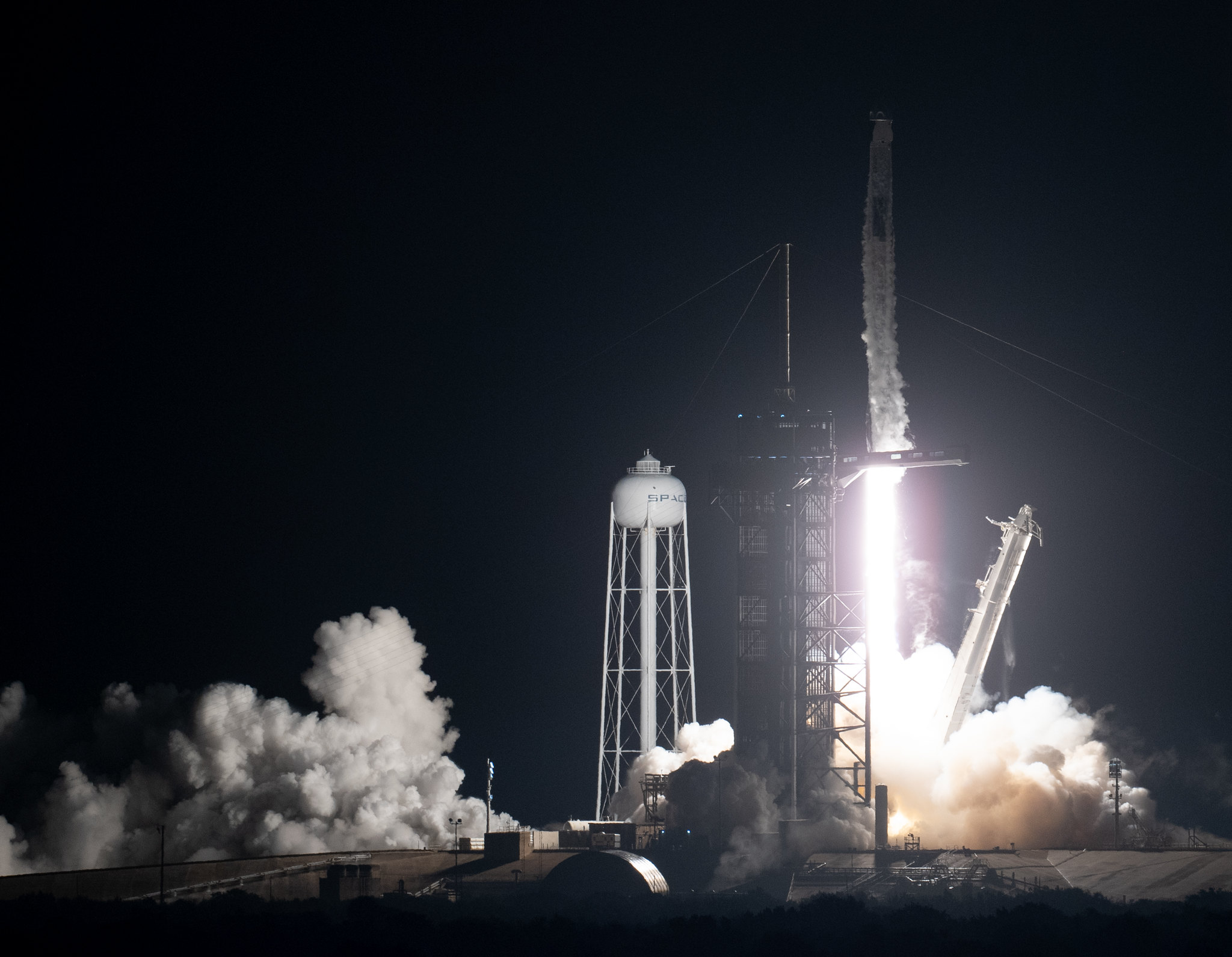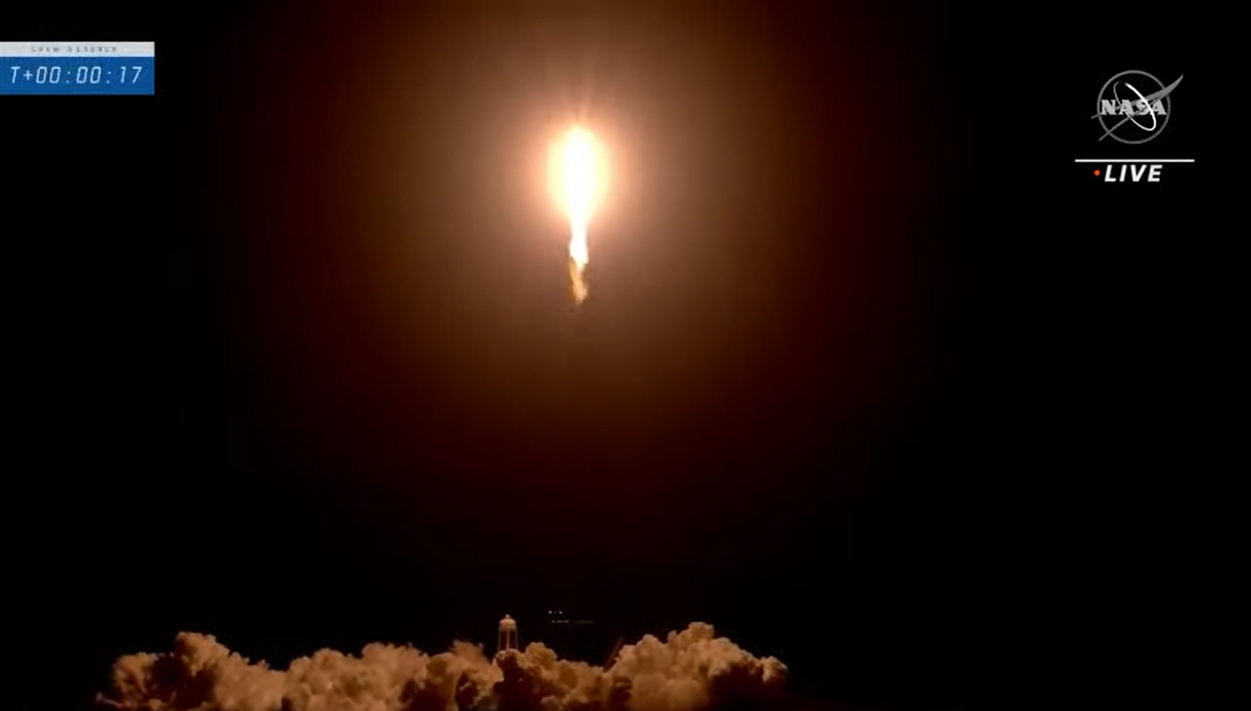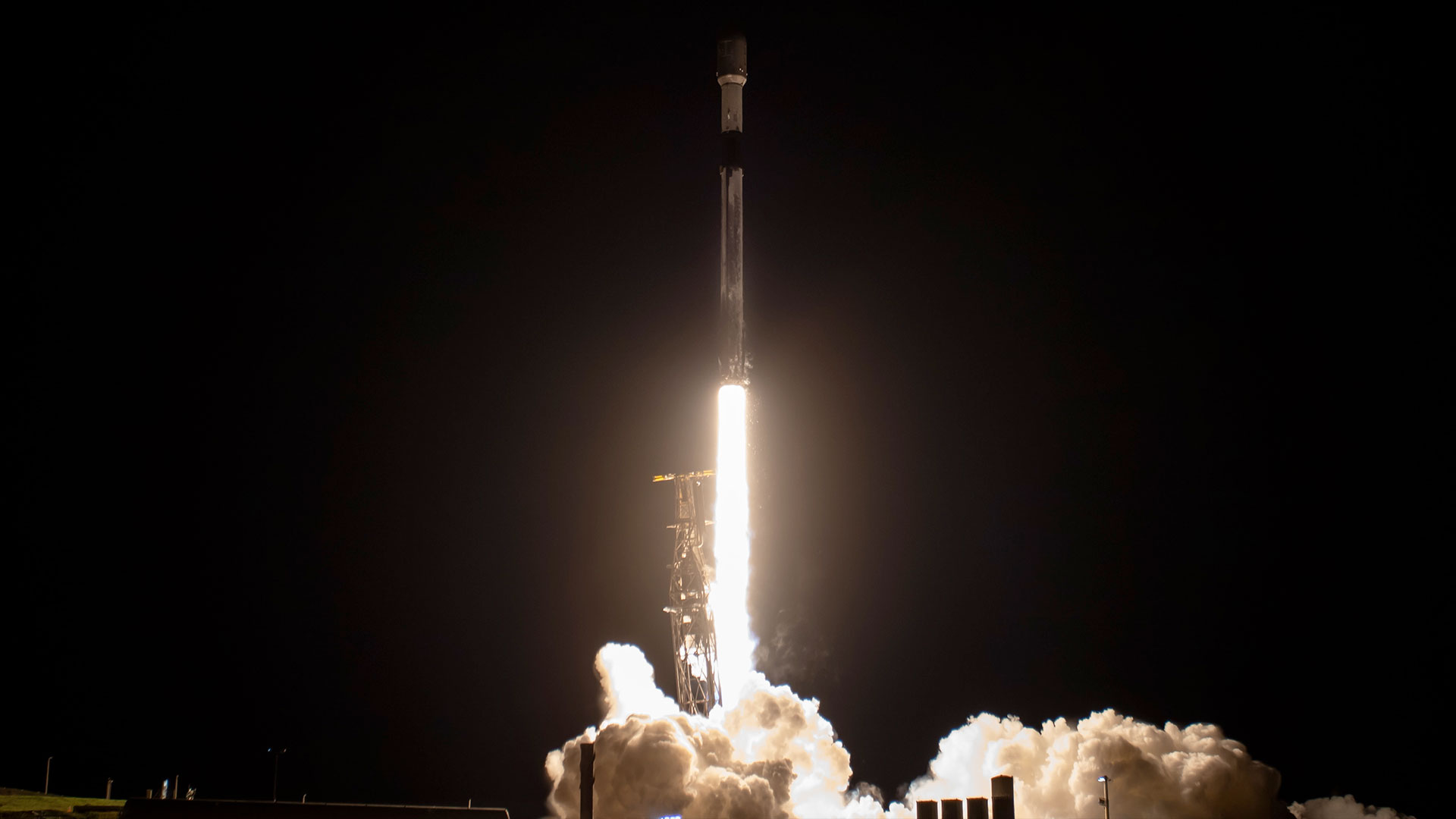SpaceX launches Crew-3 astronauts to space station for NASA in nighttime liftoff
CAPE CANAVERAL, Fla. — SpaceX just launched its fourth astronaut mission for NASA as part of the agency's commercial crew program.
A slightly sooty Falcon 9 rocket topped with a Crew Dragon capsule took to the skies above NASA's Kennedy Space Center here on Wednesday (Nov. 10) at 9:03 p.m. EST (0200 Nov. 11 GMT), lighting up the night sky as it lifted off from the agency's historic Pad 39A.
The launch kicked off SpaceX's Crew-3 mission, which will carry four astronauts — NASA's Raja Chari, Tom Marshburn and Kayla Barron, along with the European Space Agency's Matthias Maurer — on a 22-hour flight to the International Space Station (ISS).
"Thanks for the great ride; it was better than we imagined," Chari, commander of the Crew-3 mission, told NASA's mission control after the crew arrived safely in orbit.
Live updates: SpaceX's Crew-3 astronaut mission for NASA

Following a series of weather-related delays, the Crew-3 launch countdown proceeded smoothly, with the closeout crews completing critical leak and communications checks ahead of schedule. The crew seemed relaxed and ready for the action as the minutes ticked away.
"What a beautiful launch," NASA associate administrator Bob Cabana said during the live broadcast. "It was another great experience seeing those four take off into space tonight."
Breaking space news, the latest updates on rocket launches, skywatching events and more!
Once the Falcon 9's first stage engines ignited, the rocket put on a breathtaking show as the glow from the engines lit up the night sky.
"Sometimes when you try to fly on Halloween, you get a trick instead of a treat," Chari radioed SpaceX flight controllers just before liftoff. "We're honored to fly Endurance on Veterans Day and we're proud to represent the SpaceX and NASA teams as we live and work on the ISS for the next six months."
The Crew-3 launch marked the 25th launch of the year here in Florida and the 24th so far this year for SpaceX. While the rocket was one of SpaceX's veteran flyers, launching on its second mission, the Dragon Crew capsule was brand new.
Dubbed Dragon Endurance by its Crew, the capsule is carrying Crew-3 on a six-month mission aboard the ISS. The picture-perfect launch occurred just 12 days after it was originally scheduled to blast off. Chari, Marshburn, Barron and Maurer arrived in Florida on Oct. 26, days before their planned Halloween launch.
Poor weather along the rocket's flight path pushed back the launch a few days. It was delayed further by continued bad weather and a minor medical issue with one of the astronauts. (NASA did not elaborate on the issue due to privacy reasons for the astronaut.)
To that end, the agency decided it was best to bring the previous group of astronauts — NASA's Shane Kimbrough and Megan McArthur, ESA's Thomas Pesquet and Japan Aerospace Exploration Agency's Akihiko Hoshide — home before launching their replacements.
Those astronauts strapped into their own Dragon and departed the space station on Monday afternoon, splashing down in the Gulf of Mexico hours later. Already back in Houston and with their families, the crew left NASA astronaut Mark Vande Hei in charge of acquainting the Crew-3 crew members with the ISS.
Marshburn, who is the only veteran space flyer on the Crew-3 mission, told Space.com prior to launch that he was really looking forward to experiencing spaceflight with his three crewmates who have never been to space. In fact, Barron has never seen a rocket launch before. Her own flight was her first-ever launch and her first time flying in space.
SpaceX ramping up
As part of NASA's first human spaceflight program, Project Mercury, the agency launched a total of six people into space in the early years of the space age. With today's liftoff, SpaceX has now put 18 people into orbit in less than two years, including four private citizens who flew on a three-day trip around the Earth as part of the Inspiration4 mission.
Four of those five flights have been part of NASA's Commercial Crew Program, which contracted private companies to build spacecraft capable of ferrying astronauts to and from the ISS. The program was designed to help foster a commercial economy in low Earth orbit, where NASA is a customer instead of the provider. This way, the agency could hire a space taxi service (like the Crew Dragon) to run back and forth between Earth and ISS, freeing the agency up to focus on more deep-space exploration projects like Artemis. (Artemis is NASA's newest lunar exploration program which focuses on returning humans to the moon.)
NASA relied on its fleet of space shuttles to not only transport astronauts to space, but also to help build the International Space Station, which has been continuously occupied for more than 20 years now. But the shuttle's days were limited. Just before its retirement, NASA decided that it wanted to hand over the reins of low Earth orbit to private industry and entrusted two companies — SpaceX and Boeing — to ferry agency astronauts to and from space. SpaceX built Crew Dragon, an advanced variant of its robotic Dragon cargo capsule, and Boeing is developing a capsule called CST-100 Starliner.
Crew Dragon launched its fourth crew of astronauts for NASA on Wednesday (its fifth Crew Dragon flight overall), while Boeing's Starliner spacecraft is struggling to get off the launchpad. The company launched its first crew capsule in 2019 as part of an uncrewed flight test that would see the capsule launch, dock itself to the space station, and land. Unfortunately, during that flight, the craft experienced an anomaly and was unable to reach the space station. Subsequent analysis showed multiple issues with the capsule's software.
Boeing and NASA spent 18 months pouring over the data and making adjustments to both the software and the spacecraft. In August the company tried to launch Starliner on a second uncrewed test, but a combination of bad weather and an anomaly within the capsule's propulsion system kept it grounded.
Valves inside the spacecraft that control its propellant were stuck closed, and the team tried to troubleshoot and were able to unstick the majority of the valves; however, crews were unable to unstick the remaining four valves and had to transport the Starliner back into the Boeing facilities here at the Cape. Currently, the launch is on hold indefinitely as the teams work to resolve the issue.
"Go" for launch
Going into the Crew-3 launch on Wednesday, the only concern was the weather. Teams from NASA and SpaceX met Tuesday night (Nov. 9) to discuss the mission prior to giving the official go-ahead for launch.
During the Crew-2 splashdown, one of the Dragon's four main parachutes was a little slow to deploy, raising concern for the upcoming Crew-3 flight. Both SpaceX and NASA said that the chute worked as expected, with the rate of descent occurring as expected.
"We had one parachute [on the Crew-2 Dragon] that inflated a little slower than the others," Steve Stich, NASA's Commercial Crew Program manager said Tuesday during the briefing . "But the landing rates were nominal. We've poured over the data and convinced ourselves that we are in good shape for launch."
The four Crew-3 astronauts traveled to the pad approximately three hours before launch this morning, riding in white Tesla Model Xs adorned with the old NASA "worm" logo. Upon arrival, they took an elevator to the crew access arm, which stands approximately 265 feet (81 meters) above the launch pad, and then climbed into the capsule.
After a series of system checkouts, they then armed the Crew Dragon's abort system, a crucial component in keeping them safe in the event of a launch emergency. SpaceX then began fueling the rocket with supercooled liquid oxygen and kerosene 45 minutes before liftoff.
Endurance is expected to dock with the space station on Thursday (Nov. 11) at 7:10 p.m. EST (0010 Nov. 12 GMT). The capsule and its crew will remain at the orbital outpost for six months.
Falcon's flight



Today's mission marks the 127th flight of SpaceX's workhorse Falcon 9 rocket, and the 93rd landing of a first stage booster.
SpaceX recovered its first Falcon 9 booster in December 2015. That first stage delivered a communications satellite into space for OrbComm before returning to Earth and touching down on terra firma at SpaceX's landing pad here in Florida.
A few months later, the company recovered its first booster on a floating platform at sea, known as a drone ship. Currently, SpaceX has two drone ships in its fleet, named "Of Course I Still Love You" (OCISLY) and "Just Read the Instructions" (JRTI). Landing on a drone ship at sea is less convenient than solid ground but requires significantly less fuel.
Having two drone ships at its disposal has helped SpaceX with its reusability efforts. In 2020, the company launched a record 26 missions, and only five of those were on brand-new rockets. The rest were on reused Falcon 9 rockets, and most of those recoveries came on the deck of a drone ship.
In 2021, SpaceX moved its most prolific booster catcher OCISLY to the West Coast as it plans on ramping up launches from its California-based launch facilities. The company then introduced a third drone ship to the fleet, called A Shortfall of Gravitas (ASOG).
That drone ship comes with some significant upgrades over its predecessors, including the ability to drive itself. It still needs a tug in and out of Port Canaveral, but eventually, ASOG will be able to drive itself to and from the recovery zones.
SpaceX originally planned for JRTI to be the recovery vessel for the Crew-3 mission, but because of the delays, the drone ship was forced to ride out rough seas out in the Atlantic. SpaceX's Bill Gerstenmeier told Space.com that even though the drone ships are built to withstand rough seas, this particular ship was subjected to several days of 20- to 25-foot-tall seas and the team opted to switch ships so that the JRTI crews could rest.
ASOG departed Port Canaveral on Tuesday to support the Crew-3 mission, arriving at the designated recovery zone to await its returning booster a few hours before launch. At approximately 9:09 p.m. EST (0209 GMT on Nov. 11), the booster's flight ended with the 93rd landing of a Falcon 9 first stage and the second catch for ASOG.
Following today's launch, the crew will dock with the orbital outpost on Thursday at 7:10 p.m. EST (0010 GMT on Nov. 12), 22 hours after liftoff. You can watch the docking and follow the mission live here on Space.com.
Follow Amy Thompson on Twitter @astrogingersnap. Follow us on Twitter @Spacedotcom or Facebook.

Amy Thompson is a Florida-based space and science journalist, who joined Space.com as a contributing writer in 2015. She's passionate about all things space and is a huge science and science-fiction geek. Star Wars is her favorite fandom, with that sassy little droid, R2D2 being her favorite. She studied science at the University of Florida, earning a degree in microbiology. Her work has also been published in Newsweek, VICE, Smithsonian, and many more. Now she chases rockets, writing about launches, commercial space, space station science, and everything in between.


